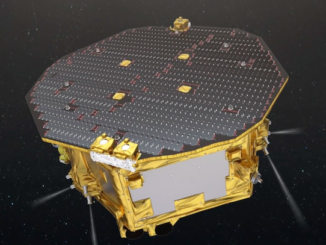
Gravitational Waves


Earth observation, deep space exploration big winners in new ESA budget
European Space Agency member states on Thursday committed nearly 12.5 billion euros ($13.8 billion) to fund ESA programs over the next three years, promising money to grow Europe’s fleet of satellites studying Earth’s changing climate, contribute to NASA-led lunar exploration efforts, and continue ESA’s participation in the International Space Station until 2030.

Neutron star collision an astronomical gold mine
On Aug. 17, gravity waves rippled through the solar system, slightly squeezing and stretching the space Earth occupies, the result of a catastrophic collision of two compact-but-massive neutron stars, producing a so-called “kilonova” explosion that seeded the local environment with a flood of heavy elements ranging from gold and platinum to uranium and beyond, scientists said Monday.

Pioneering probe for gravitational wave observatory ends mission
The European Space Agency’s LISA Pathfinder spacecraft, now sailing around the sun on a trajectory away from Earth, was deactivated Tuesday after a nearly 18-month mission testing previously-untried lasers, vacuum enclosures, exotic gold-platinum cubes and micro-thrusters needed for a trio of gravitational wave observatories set for launch in the 2030s.

Black holes crash together and make waves
Three billion years ago, in a third of a second, two black holes crashed into each other and merged into a single entity, converting two solar masses into energy that shook the fabric of spacetime, sending gravitational ripples across the universe that were detected on Earth last January, researchers announced Thursday.

Gravitational wave testbed repurposed as comet dust detector
In the final months of Europe’s LISA Pathfinder mission, scientists have found an unexpected use for the trailblazing testbed for a future gravitational wave observatory by tracking the tiny dings made by microscopic particles that strike the spacecraft in deep space, exploiting the impacts to learn about the population of dust grains cast off by comets and asteroids across the solar system.

LISA Pathfinder success bolsters plan for gravitational wave observatory
Europe’s LISA Pathfinder mission — a fundamental physics lab launched last year to a point a million miles from Earth — has demonstrated the mind-boggling technology required for a future space-based observatory to listen for faint, low-frequency vibrations emitted by invisible objects in the most distant pockets of the universe, scientists said this week.



Q&A with Alvaro Gimenez, ESA’s director of science
Alvaro Giménez Cañete manages the European Space Agency’s science program, a portfolio with a budget of nearly $600 million this year, and he recently spoke with Spaceflight Now about Europe’s hopes to build a gravitational wave observatory, the ExoMars mission to Mars, and tagging along with NASA’s probe to Jupiter’s moon Europa.
